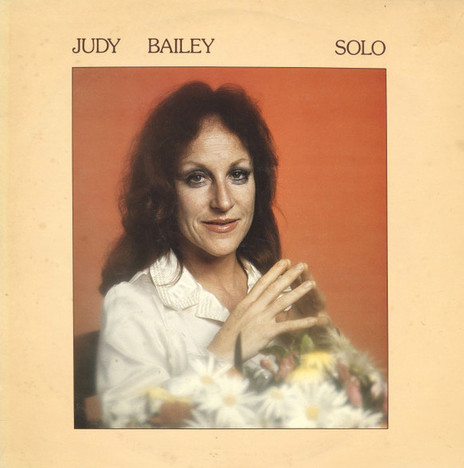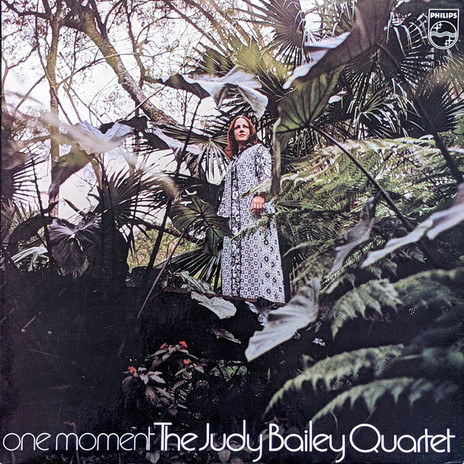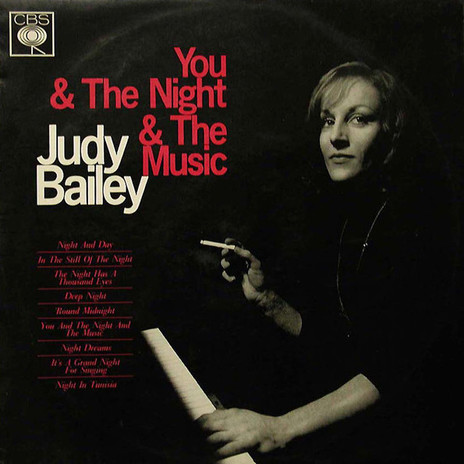You know that old joke about the instant swimming pool – just add water? I suppose instant composing implies just adding music. Building in the opportunity to instantly compose – or improvise – is of fundamental importance to the way a jazz composer creates written material. That composer is not simply creating for subsequent regurgitation, but also as a springboard for improvisation.
There is, of course, a close relationship between the improvising and the composing of a given jazz artist. Judy Bailey is no exception. Any appreciation of her compositional skills must, therefore, also deal with her improvisational skills.
As with the great Thelonious Monk, some of the most fascinating insights into her work have been provided by solo piano performances. Her 1978 recording, Solo, is case in point. Each piece here is some combination of being whimsical, evocative, compassionate and reverential.

Judy Bailey - Solo (Eureka, 1978). Cover photo by David Liddle.
I don’t think reverential is too strong a word for her reworkings of older or traditional forms, such as ‘Rag Number One’, ‘Rag Number Two’, ‘Jude’s Cakewalk’, ‘Jude’s Boogie’ and, from a 1974 quartet recording, ‘Jude’s Blues’. These pieces show sufficient veneration and knowledge of the wellsprings of jazz, to enable her to compose within a given idiom, without tampering with its form or feel. Yet the end-product remains fresh and invigorating. Particularly in the case of the ‘Rags’ and the ‘Cakewalk’, this is light-hearted music: mercurial and whimsical, without becoming frothy.
Her work is always melodically strong, and often extremely evocative. Whether Judy’s involvement in writing incidental music has honed this power of evocation, or whether the already existing power lent itself to writing programme music, I don’t know. Certainly, her ability to convey images or specific non-musical ideas is finely tuned in such works as ‘Fat Lady Waltz’, ‘The Spritely Ones’, ‘I’m Gonna Try’, ‘Rocking Horse’. ‘Sunday Sequence’, and ‘Snowflake’.
In ‘Fat Lady Waltz’, the intrinsic humour of the title is subtly carried through the music, without resorting to slapstick devices. Over a blues form, the left hand plays a rumbling laggard figure, against which the broken triplets of the right hand seem to stagger. It is possible that the lady in question is not only fat, but has had a couple of daiquiris too many.
‘The Spritely Ones’ is another musical portrait. This time, however, rather than a caricature, we have a compassionate picture of the elderly. It is gently swinging and dignified. Ms Bailey’s titles often seem to be important, and the spelling of “spritely” (rather than “sprightly”) carries connotations of the composer as an “Alice”, looking up to the aged as somehow magical or mystical, alongside the animated/lively meaning.
One of my personal favourites is ‘Ningana’. The boundaries between composition and improvisation become blurred, amid the serenity of the deftly placed rests and economy of notes. The effect is magnificent, the notes cascade, or drip like water through the leaves of a rain forest. This is something like the spell cast by the crystalline purity of ‘Snowflake’, the original theme for which, interestingly enough, was used for a “Flake” commercial.
‘Sunday Sequence’ is another favourite, in which those boundaries I spoke of are even more blurred. About six minutes in length, there is so much music here that the piece seems twice as long. I need a stronger word than evocative, as the music brings a flood of Sunday scenarios to mind. It seems to be a day that always starts sluggishly, whether one is recovering from a hangover, going to church, or browsing through a mindless Sunday paper. Even if one does have to do something domestic, like the washing, there is always more recovery time in the sun with a book, afterwards. This is Judy Bailey at her best: drawing pictures through gentle improvisation.
One of her most original compositions for group is ‘Rocking Horse’, which I have heard played both on the album One Moment (recorded in 1974), and by one of her live aggregations. There is a “Monkishness” about this piece: not a concrete matter of style, but more the playfulness of the form, as a basis for improvisation, with its accelerations and ritards. Despite these “interruptions”, ‘Rocking Horse’, like ‘Theme Three’, demonstrates the composer’s ability to come up with the works that allow a group to swing like crazy.

Judy Bailey Quartet - One Moment (Philips, 1974)
‘I’m Gonna Try’ is yet another side of her work. Over a medium rock feel, the melody comes on like a theme tune. I do not intend that to be disparaging. On the contrary, it evokes a feeling of strength of will. It is simultaneously catchy, wistful, and decisive.
Contrast is another key word in discussing her work. Not only between one piece and another, but also often within a given tune. Take ‘Night Dreams’, from her first album, You and the Night and the Music. The opening tempo is so slow, one could be forgiven for thinking it was in free time. Ms Bailey caresses silky chords on the keyboard, while Lyn Christie loads his occasional bass notes with melancholy. Unexpectedly, the dynamic level triples and the trio, with John Sangster on drums, zooms into a 24-bar burst of swinging 3/4. This just as suddenly dies, and we are returned to all the moonlight and memories of the opening.

Judy Bailey - You & The Night & The Music (CBS, 1964)
Similarly, in ‘Colours of My Dream’, from the Eureka album, Colours. we are presented with extreme variations in dynamics and feel. The song opens with tinkling bells and electric piano, to set the mood before Denise Keene enters to sing the love song lyric. Just when you are expecting a jazz ballad improvisation, the band bursts into fierce Latin/rock. A delightful wordless melody is sung over the top in the style of Flora Purim. Both Ken James on tenor, and Judy on electric piano then take raging solos, until there is a reprise of the ballad section. The composition is definitely lifted by this contrast.
With maximum sustain on the electric piano, the unison melody line with the flute on ‘The Eleven Eight Song’ is striking. Their long notes hover over the 11/8 bass riff of Ron Philpott. The piece is originated without drums, giving a more academic. less ethnic mood.
When a jazz composer builds a groove into the melody, the result is always a tune that lends itself to the most logical and coherent improvisations. The lilting bossa nova ‘One Moment’ is such a piece. On the quartet version, both Judy Bailey on electric piano, and Ken James on tenor sax. improvise fluently around the melody, rather than just running the chord changes. And surely, in jazz terms, the mark of a fine composer is one whose pieces generate memorable improvisations.
A further version of ‘One Moment’ was arranged by Ms Bailey for a medium-sized orchestra, and recorded by the ABC. The understated, spiralling strings add poignancy as the statement of theme shifts between flute, oboe, flugelhorn, and piano.
The opportunity to arrange on this scale is a rare one, indeed, for a jazz-based artist. It would seem that Judy Bailey’s skill as an arranger must be added to her achievements as a composer and improviser.
--
John Shand is a Sydney freelance writer and musician. This article first appeared in APRA (Australia), March 1986, as “Judy Bailey’s Recorded Music: An Appreciation”, and is republished with the permission of APRA.